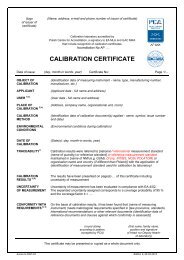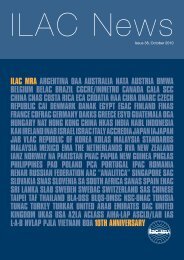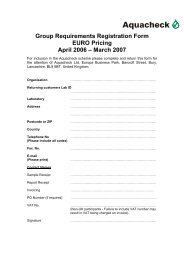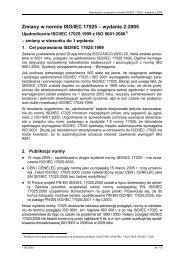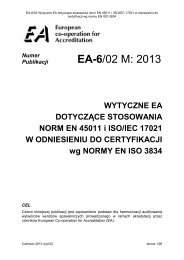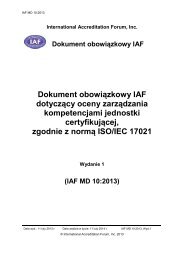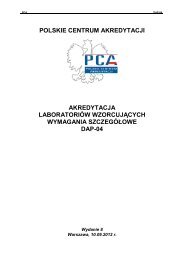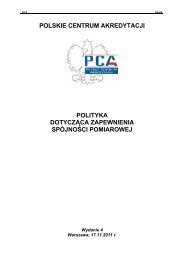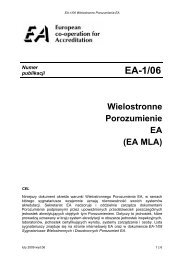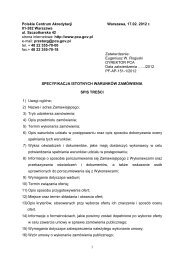w w .il a c.org ⢠ILAC, IAF and IEC CAB Commence a New Phase of ...
w w .il a c.org ⢠ILAC, IAF and IEC CAB Commence a New Phase of ...
w w .il a c.org ⢠ILAC, IAF and IEC CAB Commence a New Phase of ...
- No tags were found...
You also want an ePaper? Increase the reach of your titles
YUMPU automatically turns print PDFs into web optimized ePapers that Google loves.
ContentsFrom the Chair ................................................2<strong>New</strong>s from the <strong>ILAC</strong> Secretariat .....................3<strong>ILAC</strong>, <strong>IAF</strong> <strong>and</strong> <strong>IEC</strong> <strong>CAB</strong> <strong>Commence</strong> a<strong>New</strong> <strong>Phase</strong> <strong>of</strong> Cooperation............................5<strong>ILAC</strong> Committee newsSADC Marketing Workshop.............................6International update<strong>ILAC</strong> Work proposal in 2006 leads to anew International St<strong>and</strong>ard for PT in 2010........7ISO publishes new st<strong>and</strong>ard for ReferenceMaterial Producers (RMPs).............................8Regional cooperationsFrom the APLAC Secretariat................................9A Great Leap for EA.......................................10EA Membership <strong>and</strong> Cooperation:State <strong>of</strong> play in early 2010............................11EA is st<strong>and</strong>ing on its own two feet................12IAAC Report...................................................12Accreditation updateITALY unifies accreditation system................18COFRAC Health at the Heart<strong>of</strong> Accreditation.............................................18CALA Honoured to Host <strong>ILAC</strong>/<strong>IAF</strong> 2009 ......19Argentine Accreditation Body:Winner <strong>of</strong> the National Quality Award...........21Accreditation Week 2009 in Cyprus..............22DAC becomes <strong>ILAC</strong> MRA signatory..............24The Egyptian AccreditationCounc<strong>il</strong> “EGAC”...........................................25ema’s National Strategy to StrengthenAccreditation <strong>and</strong> Conformity Assessment...26SADCAS <strong>and</strong> SANAS sign Twinningpartnership arrangement..............................27Re-regulation <strong>of</strong> Swedish vehicle inspection....28Croatian Accreditation Agency (HAA)............30Hong Kong to Promote the Development<strong>of</strong> the Testing <strong>and</strong> Certification Industry.......31MAURITAS Accredits The Plant PathologyLaboratory <strong>of</strong> AREU......................................32MAURITAS participates in the 1stSADC set week.............................................32<strong>New</strong>s from TAF..............................................33StakeholdersEUROLAB workshop on Accreditationwith flexible scope........................................34From the ChairThe past year has been a very important one for <strong>ILAC</strong>during which we have registered several importantachievements.First <strong>of</strong> all, I wish to mention the ever increasinginternational recognition <strong>of</strong> the <strong>ILAC</strong> Arrangement.In this respect, more US regulators (the ConsumerProduct Safety Commission (CPSC) for toy testing <strong>and</strong>the Nuclear Regulatory Commission (NRC) in thenuclear area) have clearly expressed their wish to rely onlaboratories accredited by <strong>ILAC</strong> Full Members. In the same vein, <strong>ILAC</strong> is nowalso mentioned as a key player by the United Nations.The relationship with <strong>IEC</strong> is another success story. In 2010, we arecommencing a new concept <strong>of</strong> cooperation, replacing the onsite joint <strong>ILAC</strong>/<strong>IEC</strong> or <strong>IAF</strong>/<strong>IEC</strong> assessments <strong>of</strong> conformity assessment bodies by a uniqueassessment led by the <strong>ILAC</strong> Full Member accreditation body in the case <strong>of</strong> alaboratory <strong>and</strong> by the <strong>IAF</strong> MLA signatory in the case <strong>of</strong> a certification body<strong>and</strong> using technical experts, chosen by the accreditation body, from a list <strong>of</strong>experts qualified by the <strong>IEC</strong>. This new concept w<strong>il</strong>l be <strong>of</strong> great benefit forlaboratories <strong>and</strong> product certification bodies, diminishing the overall cost <strong>of</strong>achieving both accreditation <strong>and</strong> recognition by <strong>IEC</strong>.The continued excellent cooperation with WADA must also be highlighted.The training <strong>of</strong> accreditation technical experts by WADA is conducted on anannual basis <strong>and</strong> WADA relies on accreditation by <strong>ILAC</strong> members to ensurethe competence <strong>of</strong> their recognised laboratories.All these examples are very good signs.Certainly, there is a lot <strong>of</strong> progress st<strong>il</strong>l to be made in many other fields butwe are on the right track.However, I wish to underline again that making the accreditation conceptmore well-known <strong>and</strong> the benefits <strong>of</strong> international recognition through MLAsat the worldwide level more visible, requires a robust cooperation with <strong>IAF</strong>,our sister <strong>org</strong>anisation.In this respect, the negative results <strong>of</strong> the ballots conducted at the end <strong>of</strong>2009, about the future <strong>of</strong> the two <strong>org</strong>anisations, should not be considered asan end to this cooperation.Nearly two thirds <strong>of</strong> the members <strong>of</strong> each <strong>org</strong>anisation expressed their wishto have a unique worldwide cooperation <strong>of</strong> accreditation bodies. According toour voting rules this was not sufficient (seventy five percent majority required)to achieve such a change.However, this result definitely does not prevent <strong>ILAC</strong> <strong>and</strong> <strong>IAF</strong> fromstrengthening their cooperation for the benefit <strong>of</strong> all accreditation bodymembers, stakeholders <strong>and</strong> beyond them to the global economy.Let us improve our efficiency!<strong>ILAC</strong> Publications.................................35© <strong>ILAC</strong> <strong>New</strong>s 2010Produced by NATA Communications.<strong>ILAC</strong> <strong>New</strong>s is published twice a year by the <strong>ILAC</strong> Secretariat.Contributions represent the view <strong>of</strong> the authors. Such views <strong>and</strong>opinions do not necessar<strong>il</strong>y reflect <strong>ILAC</strong> Policy.Daniel PierreChair2 Issue 37 | Apr<strong>il</strong> 2010
<strong>ILAC</strong> <strong>New</strong>s| Regional CooperationsA Great Leap forwardfor EAEA has been appointed by the EuropeanCommission as the <strong>of</strong>ficial Europeanaccreditation infrastructure. Theappointment became effective on 1 Apr<strong>il</strong>2009 in Brussels when the Guidelinesfor Cooperation between the EuropeanCommission (EC), the EFTA, EA <strong>and</strong>the competent national authorities weresigned I . The Guidelines set out thecommon policy objectives <strong>and</strong> principles<strong>of</strong> cooperation agreed by the parties.The appointment <strong>of</strong> EA as the <strong>of</strong>ficialEuropean accreditation infrastructurefollows the adoption <strong>of</strong> Regulation (EC) no765/2008 <strong>of</strong> the European Parliament <strong>and</strong>the Counc<strong>il</strong> <strong>of</strong> 9 July 2008 establishing alegal framework for accreditation in theEU/EFTA member states. This regulationcame into effect as <strong>of</strong> 1 January 2010.A consequence <strong>of</strong> the appointmentrequires that EA revises its Articles <strong>of</strong>Association <strong>and</strong> Rules <strong>of</strong> Procedure toreflect EA’s new role <strong>and</strong> responsib<strong>il</strong>ities.To fulf<strong>il</strong> this enhanced role to harmonisethe accreditation criteria applied to <strong>CAB</strong>s,EA has defined horizontal criteria forconformity assessment bodies (<strong>CAB</strong>s)seeking accreditation for notificationpurposes, to be applied with relevantharmonised st<strong>and</strong>ards, guidancedocuments <strong>and</strong> Community or nationalrequirements II .To achieve consistency throughoutEurope, in addition to greater transparency<strong>and</strong> acceptab<strong>il</strong>ity to all, includingnational authorities, the peer-evaluationprocess w<strong>il</strong>l need to be ta<strong>il</strong>ored t<strong>of</strong>ully accommodate the specific needs<strong>of</strong> regulatory sectors to strengthen thereassurance <strong>of</strong> sectoral stakeholders <strong>and</strong>regulators that the accreditation bodies’technical competence is thoroughlyassessed.To meet such ambitions, 13 directivenetworks covering 21 <strong>New</strong> ApproachDirectives have been established to collect,structure <strong>and</strong> make accessible all technicalknowledge required for <strong>CAB</strong>s’ assessment.Progress <strong>of</strong> this wide-ranging task, whichreflects the high expectations set by thecompetent national authorities, w<strong>il</strong>l bereported to <strong>and</strong> monitored by the new EAHorizontal Harmonization Committee.Communication is a pivotal functionfor the consistent implementation <strong>of</strong> thenew regulation. The latter formalisesEA members’ obligations to satisfy theexpectations <strong>of</strong> national authorities <strong>and</strong>stakeholders, which entrust greaterresponsib<strong>il</strong>ity from their nationalaccreditation body (NAB). A BestPractice Guide on Communications withthe Regulators has been published toassist EA <strong>and</strong> its members to develop<strong>and</strong> strengthen cooperation with bothnational <strong>and</strong> European regulators III .Sim<strong>il</strong>arly EA itself shall enhance itscommunications with the EC: EA shallattend every SOGS IV meeting dealingwith accreditation, as well as meetings<strong>of</strong> the EC Inter-Service Steering Groupfor Accreditation in order to discussthe benefits <strong>of</strong> accreditation with thevarious EC services; projects are alreadyunderway with DGs Environment,Transport, Health & Consumer <strong>and</strong>Agriculture.EA is also required to consult<strong>and</strong> interact in a more efficient <strong>and</strong>transparent way with its stakeholders.The EA Advisory Board (EAAB) shall bethe “appropriate structure to ensure theeffective <strong>and</strong> balanced involvement <strong>of</strong> allinterested parties”, particularly to managethe increasing number <strong>of</strong> bodies wishingto become EA stakeholders. The EAABTerms <strong>of</strong> Reference have been revisedaccordingly.Moreover, the EA Policy for Relationswith Stakeholders (as defined inEA-1/15) has been adopted in order t<strong>of</strong>ormally grant a distinct status withassociated rights <strong>and</strong> obligations to those“recognised” stakeholders who wish tobecome more directly involved in EA’sassociative life <strong>and</strong> have a particularinstitutional interest in contributing toEA’s technical activities without, however,meeting the criteria for becoming EA fullmembers.Remaining issues to be resolved by EAin 2010 include cross-border accreditation<strong>and</strong> transitional measures for accreditationcertificates according to article 39 in theRegulation.A Framework Partnership Agreement(FPA) with the EC is st<strong>il</strong>l underdiscussion. The FPA w<strong>il</strong>l specify the tasksEA w<strong>il</strong>l be obliged to perform accordingto Regulation 765 <strong>and</strong> the Guidelinessigned. The activities EA shall completefollowing the FPA w<strong>il</strong>l be specified in anEA Work Programme, which shall alsobe approved by the Commission. TheCommission w<strong>il</strong>l provide funding to EAenabling EA to deliver the services agreedin the work programme <strong>and</strong> relatedbudget.”IA link to the Guidelines is ava<strong>il</strong>able on the Homepage <strong>of</strong> the EA website.IISee EA-2/17: EA Guidance on the horizontal requirements for the accreditation <strong>of</strong> conformity assessment bodies for notification purposes.IIIA link to the Best Practice Guide is ava<strong>il</strong>able on the EA website, section Communication Materials / Communication with Regulators.IV The SOGS (Senior Officials Group on St<strong>and</strong>ards <strong>and</strong> Conformity Assessment Policy) is an advisory committee to the European Commission dedicated to conformityassessment <strong>and</strong> st<strong>and</strong>ardisation issues.10 Issue 37 | Apr<strong>il</strong> 2010
<strong>ILAC</strong> <strong>New</strong>s| Regional CooperationsEA Membership <strong>and</strong>Cooperation: State <strong>of</strong> play inearly 2010German <strong>and</strong> Italian regulatoryadjustmentsIn accordance with European Regulationno 765/2008 which states that each nationalauthority in the EU Member States shallestablish one single national accreditationbody in charge <strong>of</strong> all accreditations, someadjustments have been carried out within theEA membership.The restructuring process <strong>of</strong> the Germanaccreditation system has been successfullycompleted. The merger <strong>of</strong> DACH, DAP<strong>and</strong> TGA to form DGA has been acceptedby EA as a full member. EA MLA signatorystatus has also been transferred to DGA. Thejoint transfer <strong>of</strong> full EA membership fromDKD <strong>and</strong> DGA to a new legal entity namedDAkkS (Deustche AkkreditierungstelleGmbH) was also agreed at the 24th EAGeneral Assembly held in November2009. DAkkS has been formally entrustedwith public tasks <strong>of</strong> the German nationalaccreditation body by the Federal Republic<strong>of</strong> Germany.The restructuring process is also underwayto the Italian accreditation system. TheEA full membership <strong>and</strong> signatorystatus have been jointly transferred fromSINCERT <strong>and</strong> SINAL to ACCREDIA(responsible for the accreditation <strong>of</strong> testing,product <strong>and</strong> quality system certification,personnel certification, EMS certification<strong>and</strong> inspection). Sim<strong>il</strong>arly, the EA fullmembership <strong>and</strong> signatory status <strong>of</strong> SIT hasbeen transferred to COPA, responsible forthe accreditation <strong>of</strong> calibration. On 8 January2010, EA was informed that ACCREDIAhas been appointed as the Italian nationalaccreditation body for all scopes, includingcalibration.To date, the EA fam<strong>il</strong>y numbers 33full members representing 33 Europeancountries. Among these, there are 29The whole EA community attending the 24th EA General Assembly held on 25 <strong>and</strong> 26 November2009 in Bruges, Belgium.A break in the meeting room for the 24th EA General Assembly held on 25 <strong>and</strong> 26 November 2009in Bruges, Belgium.signatories to the EA MLA, <strong>of</strong> which 20have signed for all accreditation activitiespresently covered by the EA MLA.Extended EA cooperation withnon-European countriesTwenty non-European accreditationbodies have signed a contract <strong>of</strong> cooperationwith EA. The last four signatories includethe accreditation bodies <strong>of</strong> Montenegro,Kazakhstan, Kosovo under the UNSCResolution 1244/1999 <strong>and</strong> Ge<strong>org</strong>ia.Eleven <strong>of</strong> these contracts <strong>of</strong> cooperationhave developed into b<strong>il</strong>ateral agreementswith EA.A2LA b<strong>il</strong>ateral agreementwith EAThe contract <strong>of</strong> cooperation betweenEA <strong>and</strong> A2LA <strong>and</strong> the related b<strong>il</strong>ateralagreement has been terminated by A2LAin 2009 because <strong>of</strong> A2LA’s difficulties infulf<strong>il</strong>ling the future requirements set by EApursuant to Regulation (EC) no 765/2008.<strong>ILAC</strong> <strong>New</strong>s11
<strong>ILAC</strong> <strong>New</strong>s| Regional CooperationsEA is st<strong>and</strong>ing on itsown two feetTo effectively carry out its new role, asdefined in Regulation (EC) no 765/2008which comes into effect from 2010, EA hasgained full independence from COFRAC, theFrench national accreditation body. Takingthe appropriate legal advice, EA has formallydeclared that the Paris <strong>of</strong>fices w<strong>il</strong>l accommodatethe EA Secretariat <strong>and</strong> that EA w<strong>il</strong>l become thedirect employer <strong>of</strong> its current three members <strong>of</strong>staff.In 2006, the EA Secretariat was establishedas a permanent structure in France. Following a4-year p<strong>il</strong>ot phase from 2006 to 2009, the EAGeneral Assembly agreed on the transfer <strong>of</strong> stafffrom COFRAC to EA in May 2009. The signing<strong>of</strong> the agreement with COFRAC <strong>and</strong> the threeindividual employment contracts took place on17 December 2009, which w<strong>il</strong>l remain a redletterday in EA’s story. All agreements becameeffective on 1 January 2010.The EA accounts, which have previously beenincluded in the COFRAC reporting systemduring the p<strong>il</strong>ot phase, have subsequentlybeen transferred to an independent accountingcompany in Paris.The employment <strong>of</strong> the EA Secretariat proves asignificant m<strong>il</strong>estone for the Association, whichhas now clearly entered into a new phase <strong>of</strong> itsexistence as Europe’s accreditation structurein order to meet both the challenges <strong>of</strong> itsnew role <strong>and</strong> the expectations <strong>of</strong> its numerousstakeholders.Signing <strong>of</strong> the EA-COFRAC transfer agreement between Graham Talbot, EA Chairman (left), <strong>and</strong> DanielPierre, COFRAC Managing Director (right), on 17 December 2009 in Paris.Signing <strong>of</strong> the employment contracts with EA by the 3 staff members <strong>of</strong> the Paris Secretariat on 17December 2009. From left to right: Frédérique Laudinet, Martine Blum <strong>and</strong> Bénédicte Ziemann.IAAC ReportThis report includes IAAC activities from September 2009 to December 2009.IAAC MLA scope extensionThe Inter American AccreditationCooperation (IAAC) has submitted anapplication to extend its <strong>IAF</strong> MLA forthe scopes <strong>of</strong> accreditation <strong>of</strong> Product<strong>and</strong> Environmental Management SystemsCertification Bodies, <strong>and</strong> for InspectionBodies. Currently, IAAC is a RegionalCooperation Body signatory <strong>of</strong> the<strong>ILAC</strong> MRA with a scope in Testing<strong>and</strong> Calibration Laboratories, <strong>and</strong> also asignatory <strong>of</strong> the <strong>IAF</strong> MLA with a scopein QMS.IAAC has started operating MLAsfor the scopes <strong>of</strong> EMS CertificationBodies, Product Certification Bodies <strong>and</strong>Inspection Bodies.The <strong>ILAC</strong>-<strong>IAF</strong> evaluation teamleader performed an evaluation <strong>of</strong>the IAAC MLA Group, <strong>and</strong> theMLA Committee, on 29-30 August2009 <strong>and</strong> also evaluated the IAACSecretariat on 1-2 September 2009, inCosta Rica.12Issue 37 | Apr<strong>il</strong> 2010
from previoust pageMarch 2010• Workshop on clinical/medicallaboratory accreditation based on ISO15189 in Santo Domingo, DominicanRepublic held on 11-13 November2009• Workshop on Food Certification washeld in Buenos Aires, Argentina on28-30 September 2009• A peer evaluator training workshopwas held in San Jose, Costa Rica, on 4September 2009• Seminar “Market surve<strong>il</strong>lance throughaccredited Conformity AssessmentBodies” was held in San Jose, CostaRica, on 3 September 2009.IAAC Pr<strong>of</strong>iciency TestingprogramsIAAC T005 Pr<strong>of</strong>iciency Test forpreservatives in non-alcoholic beverages.An IAAC regional pr<strong>of</strong>iciency testingprogram on preservative analysis in nonalcoholic beverages is being <strong>org</strong>anisedby OAA/INTI <strong>of</strong> Argentina <strong>and</strong> w<strong>il</strong>l bestarting soon. Invitations w<strong>il</strong>l be sent toIAAC, APLAC <strong>and</strong> SADCA members.IAAC T004 Pr<strong>of</strong>iciency Test forWine. An IAAC regional pr<strong>of</strong>iciencytesting program on wine analysis isbeing carried out by DTA-IBMETRO<strong>of</strong> Bolivia. Registration began in Apr<strong>il</strong>2009 <strong>and</strong> the distribution <strong>of</strong> samples iscurrently underway. This program includeslaboratories from the IAAC <strong>and</strong> APLACregions.IAAC T003 Pr<strong>of</strong>iciency Test for FattyAcids. An IAAC regional pr<strong>of</strong>iciencytesting program on Fatty Acid compositionin Vegetable O<strong>il</strong> is being carried outby OAA/INTI <strong>of</strong> Argentina. Thisprogram began in November 2008 <strong>and</strong>the preliminary report is being finalised.Laboratories from the IAAC region as wellas laboratories from 8 APLAC members<strong>and</strong> 2 SADCA members participated.IAAC T002 Pr<strong>of</strong>iciency Test forThermocouples. An IAAC regionalpr<strong>of</strong>iciency testing program on Type KThermocouples <strong>org</strong>anised by ECA, CostaRica, <strong>and</strong> NVLAP <strong>of</strong> USA began in Apr<strong>il</strong>2009 <strong>and</strong> is currently underway. Thisprogram includes laboratories from theIAAC, APLAC <strong>and</strong> SADCA regions.Cooperation withinternational <strong>and</strong> regional<strong>org</strong>anisationsCooperation with <strong>IAF</strong>:Beatriz García, IAAC Chair, became amember <strong>of</strong> the <strong>IAF</strong> Executive Committee.R<strong>and</strong>y Dougherty, <strong>IAF</strong> Chair, provideda presentation at the IAAC GeneralAssembly meeting held in San Jose, CostaRica, on 4 September 2009.<strong>IAF</strong> <strong>and</strong> IAAC carried out the joint peerevaluation <strong>of</strong> OAA, Argentina, in 2008,<strong>and</strong> the joint evaluation <strong>of</strong> INN, Ch<strong>il</strong>e, in2009.At the request <strong>of</strong> <strong>IAF</strong>, IAAC w<strong>il</strong>lprovide two regional peer evaluators(team members) for the evaluation <strong>of</strong> PACin 2009, <strong>and</strong> IAAC w<strong>il</strong>l also provide aregional evaluator for the evaluation <strong>of</strong> EAin 2010.Cooperation with <strong>ILAC</strong>:Peter Unger, <strong>ILAC</strong> Vice-Chair, attendedthe IAAC General Assembly meetingsheld in San Jose, Costa Rica, in September2009.At the request <strong>of</strong> <strong>ILAC</strong>, IAAC provideda regional evaluator for the evaluation <strong>of</strong>APLAC.Cooperation with PAC:IAAC <strong>and</strong> PAC representatives held ameeting in Vancouver, Canada, in October2009, during the <strong>IAF</strong>/<strong>ILAC</strong> meetings,<strong>and</strong> agreed to carry out joint actions <strong>and</strong>activities aimed at strengthening tiesbetween the Regions <strong>and</strong> their members.IAAC <strong>and</strong> PAC shared f<strong>il</strong>es regarding MLAactivities, procedures <strong>and</strong> documents.Anneke Olvera <strong>of</strong> SCC represented PAC atthe IAAC General Assembly meetings heldin San Jose, Costa Rica, in September 2009.Cooperation with APLAC:Laboratories from eight APLAC membersare participating in the IAAC regionalpr<strong>of</strong>iciency testing program on “Fatty O<strong>il</strong>s”which began in 2008 <strong>and</strong> is <strong>org</strong>anised byINTI <strong>and</strong> OAA <strong>of</strong> Argentina.Laboratories from five APLAC membersare participating in the IAAC regionalpr<strong>of</strong>iciency testing program on “WineAnalysis” <strong>org</strong>anised DTA-IBMETRO <strong>of</strong>Bolivia in 2009.APLAC has invited IAAC membersto participate in its pr<strong>of</strong>iciency testingprograms during 2009.In 2009, APLAC <strong>and</strong> IAAC carried outthe joint peer evaluations <strong>of</strong> AIHA LAP,USA; NVLAP, USA; <strong>and</strong> ema, Mexico.APLAC <strong>and</strong> IAAC held a joint evaluatortraining course in Maryl<strong>and</strong>, USA, inMarch 2009. Thirteen IAAC evaluatorsattended this course <strong>and</strong> are now qualifiedas trainee evaluators <strong>and</strong> may participate inIAAC evaluations.Cooperation with EA:Graham Talbot, EA Chair, attendedthe IAAC General Assembly meetings inSan Jose, Costa Rica, in September 2009,<strong>and</strong> delivered a presentation on the EUAccreditation system. In May 2009, lleanaMartinez <strong>of</strong> NIST, USA, represented IAACat the EA General Assembly.In 2008, EA, <strong>IAF</strong> <strong>and</strong> IAAC carried outthe joint peer evaluation <strong>of</strong> Cgcre/Inmetro,Braz<strong>il</strong>.Cooperation with SADCA:Laboratories from two SADCA membersare participating in the IAAC regionalpr<strong>of</strong>iciency testing program on “Fatty O<strong>il</strong>s”<strong>org</strong>anised by INTI <strong>and</strong> OAA <strong>of</strong> Argentina.Technical Cooperation Projects:14 Issue 37 | Apr<strong>il</strong> 2010
2009-2010 Organisation <strong>of</strong> AmericanStates (OAS) ProjectIAAC is currently implementing atechnical cooperation project with theOAS for accreditation bodies in developingcountries within the Americas region.The project includes the followingactivities:• Witnessing <strong>of</strong> IAAC peer evaluations• 2 peer evaluations <strong>of</strong> ABs• Training for 3 peer evaluators• 3 technical training courses• 1 e-course or webinar• 3 consultancies to a developing AB• 3 internships for staff <strong>of</strong> developing ABs• 1 regional seminar on accreditation• 2 national seminar programs onaccreditation• 2 pr<strong>of</strong>iciency testing programs.2009-2010 PhysikalischTechnische Bundesanstalt(PTB) ProjectIAAC currently has a technicalcooperation project with PTB <strong>of</strong> Germany.The project activities for 2009-2010include:• Workshops on Good Practicesin Accreditation <strong>of</strong> Food Safety,Development <strong>of</strong> a Business Plan forAccreditation Bodies, Analysis <strong>of</strong>Pr<strong>of</strong>iciency Testing results, etc.• Internships for accreditation bodiesthat are developing the inspection bodyscheme in accreditation bodies thathave developed <strong>and</strong> established thescheme.• Training for peer evaluator trainees.• Support to carry out the internationalevaluations <strong>of</strong> IAAC <strong>and</strong> witnessing <strong>of</strong>IAAC evaluations.Improvement <strong>of</strong> IAACdocuments <strong>and</strong> proceduresThe General Assembly recentlyapproved changes to the followingdocuments in order to improve IAACprocesses: AD 001 IAAC MOU Text,AD 009 IAAC MLA Text, PR 005Procedure for h<strong>and</strong>ling complaints <strong>and</strong>appeals, PR 007 Procedure for IAACAdoption <strong>of</strong> International Documents <strong>and</strong>PR 011 Procedure for Internal Audits.The General Assembly also approvedrevisions to the following IAACdocuments: AD 001 IAAC MOU Text,AD 009 IAAC MLA Text, PR 005Procedure for h<strong>and</strong>ling complaints <strong>and</strong>appeals, PR 007 Procedure for IAACAdoption <strong>of</strong> International Documents, PR011 Procedure for Internal Audits <strong>and</strong> apolicy regarding the disclosure <strong>of</strong> IAACpeer evaluation reports.In addition, for immediateimplementation a policy regardingdisclosure <strong>of</strong> IAAC peer evaluationreports was approved, <strong>and</strong> w<strong>il</strong>l beincluded in the next revision <strong>of</strong> PR002Policies And Procedures for a Multi-Lateral Recognition Arrangement amongAccreditation Bodies. IAAC w<strong>il</strong>l inform<strong>ILAC</strong> <strong>of</strong> this decision, in accordance with<strong>ILAC</strong> P-12.IAAC meetings• The IAAC 33rd Executive Committee,MLA Committee <strong>and</strong> LaboratoriesSubcommittee meetings w<strong>il</strong>l be heldin Montevideo, Uruguay, on 22-24March 2010.• The 15th General Assembly meetingsw<strong>il</strong>l be held in Rio de Janeiro, Braz<strong>il</strong>,from 20-27 August 2009.IAAC Information <strong>and</strong>PublicationsInformation on members <strong>and</strong> IAACdocuments is ava<strong>il</strong>able at the IAACwebsite: www.iaac.<strong>org</strong>.mx.SuccessStoriesfrom <strong>ILAC</strong>SignatoriesJust a reminder thatthe <strong>ILAC</strong> MCC isalways interestedin receiving ‘goodnews’ storiesthat demonstratethe benefits <strong>of</strong>accreditation <strong>and</strong> the<strong>ILAC</strong> Arrangement.A collection <strong>of</strong>good news storiesis ava<strong>il</strong>able on the<strong>ILAC</strong> website for youto use to promotethe benefits <strong>of</strong>accreditation.If you have anyrecent good newsstories to share,please do nothesitate to ema<strong>il</strong> theSecretariat on<strong>il</strong>ac@nata.com.auwho w<strong>il</strong>l arrange forthem to be addedto the good newsstories page on the<strong>ILAC</strong> website.<strong>ILAC</strong> <strong>New</strong>s 15
<strong>ILAC</strong>/<strong>IAF</strong> VANCOUVER
MEETINGS
<strong>ILAC</strong> <strong>New</strong>s| Accreditation UpdateAccreditation UpdateITALY unifies accreditation systemThe long-awaited sanctioning <strong>of</strong>ACCREDIA as Italy’s sole <strong>of</strong>ficialaccreditation body has passed into law.Two ministerial decrees have been signedto seal ACCREDIA’s appointment, allowingItaly to meet the deadline set underRegulation (EC) 765/08.ACCREDIA was created on 15 July 2009,by the merger <strong>of</strong> SINAL <strong>and</strong> SINCERT,as a non-pr<strong>of</strong>it-distributing association, tobecome the sole National Accreditation Bodyrecognised by the Italian state.The mission, indeed, was the fullcompliance <strong>of</strong> the national accreditationsystem with the regulation <strong>of</strong> the EuropeanParliament <strong>and</strong> Commission n° 765,dated 9 July 2008 <strong>and</strong> applicable from 1January 2010, for accreditation <strong>and</strong> marketcompliance in all EU countries.The process is therefore complete: it wasinitiated in 2002 when a memor<strong>and</strong>um <strong>of</strong>underst<strong>and</strong>ing was signed by all interestedcategories. The Minister <strong>of</strong> EconomicalDevelopment defined the sole accreditationbody as a point <strong>of</strong> qualification for Italianpolitics in favour <strong>of</strong> quality.The choice <strong>of</strong> ACCREDIA is also approved<strong>of</strong> <strong>and</strong> supported by other Ministries whichare already members <strong>of</strong> the body, businessArticle 69 <strong>of</strong> the French Hospitals,Patients, Health <strong>and</strong> Territories Act, passedin summer 2009 (law dated 21 July 200918 Issue 37 | Apr<strong>il</strong> 2010ACCREDIA <strong>of</strong>fices in Rome.<strong>org</strong>anisations, normative bodies, operators<strong>of</strong> the conformity assessment system, allother ACCREDIA members, consumers <strong>and</strong>consultants.The credib<strong>il</strong>ity created by SINAL <strong>and</strong>SINCERT over time – both nationally <strong>and</strong>internationally – is a legacy which mustnot be wasted. It represents the foundationupon which a wider body can be bu<strong>il</strong>t <strong>and</strong> inwhich other competencies which have createdthe history <strong>of</strong> Italian accreditation can playa role.Collaboration <strong>and</strong> mutual supportbetween the public <strong>and</strong> private sectorsw<strong>il</strong>l increasingly be the modus oper<strong>and</strong>i <strong>of</strong>ACCREDIA President – Federico GrazioliACCREDIA. Transparency, independence<strong>and</strong> impartiality w<strong>il</strong>l be confirmed <strong>and</strong>strengthened. As it has been in the past,Italy’s commitment to an internationalrole w<strong>il</strong>l be sustained, for the benefit <strong>of</strong>enterprises <strong>and</strong> all interested operators.Within the context <strong>of</strong> the EUregulations, ACCREDIA can act as thefinal link in guaranteeing the process<strong>of</strong> conformity assessment, in boththe voluntary <strong>and</strong> m<strong>and</strong>atory sectors.ACCREDIA can combine operationalefficiency with the guarantee <strong>of</strong> respect forassociated competencies, so that the quality<strong>of</strong> the Italian economic system is assured,recognised, <strong>and</strong> given the value it merits.Health at the heart <strong>of</strong> accreditationpublished in the Official Journal on 22 July2009), renders m<strong>and</strong>atory <strong>and</strong> total (for allexamination activities) the accreditation<strong>of</strong> medical biology laboratories (MBL)in order to “provide guarantees on thequality <strong>of</strong> medical biology examinations, inparticular by setting up a procedure for theaccreditation <strong>of</strong> laboratories”.It is for this purpose that the HealthcareSection was created at C<strong>of</strong>rac in October2009, dedicated essentially, at least initially,to the accreditation <strong>of</strong> MBLs based on theISO 15189 st<strong>and</strong>ard.As <strong>of</strong> 1st January 2010, this new Section isempowered to receive accreditation requests,st<strong>il</strong>l on a voluntary basis as before, for allor part <strong>of</strong> the activity <strong>of</strong> MBLs. The firstm<strong>and</strong>atory accreditations w<strong>il</strong>l come during
<strong>ILAC</strong> <strong>New</strong>s| Accreditation Updatethe course <strong>of</strong> 2010. All medical biologylaboratories w<strong>il</strong>l have to be accredited by the1 November 2016 to be permitted to operate.Daniel Pierre, General Director <strong>of</strong> C<strong>of</strong>racadvised “Accreditation leads to betterinternal <strong>org</strong>anisation <strong>of</strong> laboratories <strong>and</strong>the formalisation <strong>of</strong> the procedures used, incompliance with the ISO 15189 st<strong>and</strong>ard.”Though he considers that, for the timebeing, patients continue to “be underinformedon this subject” <strong>and</strong> notes a certainheterogeneity in the quality <strong>of</strong> French biology“particularly regarding the pre-analysisphase”, Daniel Pierre insists on a necessaryincrease in workload caused by a growingdem<strong>and</strong> “as regular as possible, to be able tooptimise its management”.The structures particularly concerned are:• Medical biology laboratories as defined inthe Public Health Code;• All other structures performingexaminations on persons or substances<strong>of</strong> human origin, which aim to provideuseful information for the diagnosis,prevention or treatment <strong>of</strong> <strong>il</strong>lnesses or toassess the state <strong>of</strong> health <strong>of</strong> human beings(biological qualification platforms fordonations, structures that perform acts<strong>of</strong> pathological anatomy <strong>and</strong> cytology,structures that perform biologicalactivities to provide medical assistancewith procreation, etc.);• Forensic biology laboratories.The Section has undertaken to comp<strong>il</strong>e itsown documentary corpus. This activity w<strong>il</strong>lbe done essentially in accordance with thest<strong>and</strong>ard ISO 15189, complemented whereapplicable by the st<strong>and</strong>ard ISO/<strong>IEC</strong> 22870.The Section Committee, set up for theHealthcare Section at the end <strong>of</strong> 2009, metfor the first time on 18 November 2009.It has already started to revise ava<strong>il</strong>abledocuments in order to adapt them to thespecificities <strong>of</strong> human health <strong>and</strong> anyamendments to regulations. The Committeehas also begun to create specific documentsto fac<strong>il</strong>itate the implementation <strong>of</strong> theaccreditation process by medical biologylaboratories.Laurent Roullot, Communication ManagerCALA Honoured to Host <strong>ILAC</strong>/<strong>IAF</strong> 2009Not only can a great deal be learned,but a good degree <strong>of</strong> satisfaction can befelt, when one looks back into the wake <strong>of</strong>where they have just been. Assessing theoutcomes achieved when an <strong>org</strong>anisation isgiven the opportunity to host a prestigiousinternational event is both advisable <strong>and</strong>necessary if the next <strong>org</strong>anisation to host theevent is to avoid any pitfalls experienced <strong>and</strong>continue to make such events even better inthe future.For 10 days in October 2009 (10-20October 2009), the Canadian Associationfor Laboratory Accreditation Inc. (CALA)was given the priv<strong>il</strong>ege <strong>of</strong> hosting <strong>ILAC</strong>/<strong>IAF</strong>2009 in Vancouver, Canada. In reality, CALAstarted its work as host at least eighteenmonths before the actual event. A dedicatedcommittee comprised <strong>of</strong> both volunteers<strong>and</strong> staff met on average once per month toaddress an extensive list <strong>of</strong> deta<strong>il</strong>s in order toDaniel Pierre, <strong>ILAC</strong> President (left), Charles Brimley, CALA CEO (Centre) <strong>and</strong> Thomas Facklam, <strong>IAF</strong>President (Right) at the “Welcome Reception” to <strong>ILAC</strong>/<strong>IAF</strong> 2009.Caricature artist was a hit with delegates during an evening reception at the Vancouver Club.Continued next page<strong>ILAC</strong> <strong>New</strong>s19
<strong>ILAC</strong> <strong>New</strong>s| Accreditation Updatefrom previoust pageensure a successful event.<strong>ILAC</strong>/<strong>IAF</strong> 2009 brought together closeto 350 <strong>of</strong> the world’s most knowledgeablepeople from more than 65 countries, onthe subject <strong>of</strong> accreditation <strong>of</strong> conformityassessment bodies. Based on the positive <strong>and</strong>supportive feedback we received from many<strong>of</strong> the delegates, we have concluded that theconference was a tremendous success <strong>and</strong>we are truly pleased that the internationalcommunity was so supportive <strong>of</strong> ourinitiatives as the event host.To say that this event surpassed all<strong>of</strong> our expectations is somewhat <strong>of</strong> anunderstatement, since we had some veryserious initial concerns based on the severedownturn in the global economy, coupledwith the H1N1 Influenza p<strong>and</strong>emic. Earlyregistrations were in a word “dismal”but in the end, we exceeded our goal forparticipation.The success <strong>of</strong> this event would not havebeen possible without the expertise <strong>and</strong>commitment <strong>of</strong> the secretariats <strong>of</strong> both<strong>ILAC</strong> <strong>and</strong> <strong>IAF</strong>. Regular input <strong>and</strong> feedbackfrom secretariat personnel at both <strong>ILAC</strong> <strong>and</strong><strong>IAF</strong> was instrumental in precisely meeting/exceeding the needs <strong>of</strong> all the participantsat the event. We thank them for theirpr<strong>of</strong>essionalism <strong>and</strong> counsel. Our success wasin great part due to their d<strong>il</strong>igence <strong>and</strong> theirencouragement throughout.As you already know, we are very proud toCommittee meetings were very well attended throughout the event.“Mostly Marley” b<strong>and</strong> entertained delegates after the “Gala” dinner event.Magician entertains delegates during dinnercruise on Vancouver Harbour.have hosted such a successful internationalevent wh<strong>il</strong>e at the same time taking activesteps to eliminate the carbon footprint <strong>of</strong>all delegates travelling to the Vancouverevent. Former CALA CEO Rick W<strong>il</strong>sonspearheaded a tree-planting initiative thatsaw a total <strong>of</strong> 310 trees <strong>of</strong> nine major speciesplus a variety <strong>of</strong> ornamentals planted thatw<strong>il</strong>l as they grow, totally <strong>of</strong>fset this carbonfootprint from the event.In closing let me, on behalf <strong>of</strong> CALA <strong>of</strong>ferour ongoing counsel to the new committeeplanning the <strong>ILAC</strong>/<strong>IAF</strong> 2010 event inShanghai. We are at their service to hopefullyanswer any questions they may have as theyplan out what we know w<strong>il</strong>l be anothersuccessful event.Thank you once again for the opportunityto host you all here in Canada.C Charles BrimleyCALA Chief Executive Officer20 Issue 37 | Apr<strong>il</strong> 2010
<strong>ILAC</strong> <strong>New</strong>s| Accreditation UpdateArgentine Accreditation Body:Winner <strong>of</strong> the National Quality AwardThe Argentine Accreditation Body (OAA)is a pioneer, being the first accreditationbody in the world that has won theNational Quality Award.The purpose <strong>of</strong> the route towardsexcellence, that OAA has decided topursue within the quality culture, is thecontinuous improvement <strong>of</strong> the servicesit provides, both locally <strong>and</strong> abroad. Forthis purpose it has adopted the NationalQuality Award Model in addition to theinternational requirements through whichit has obtained worldwide recognition.In the course <strong>of</strong> this route <strong>of</strong> successes,OAA was granted the Special Mention forExcellence in Integral Management <strong>and</strong> theNational Quality Award in the non-pr<strong>of</strong>it<strong>org</strong>anisation category granted by the NationalQuality Award Foundation in 2009.The National Quality Award was createdin 1992 with the aim <strong>of</strong> “promotingprocesses <strong>and</strong> systems for the continuousimprovement <strong>of</strong> quality in order to supportthe upgrading <strong>and</strong> competitiveness <strong>of</strong><strong>org</strong>anisations”.The Award was presented by the NationsPresident, Dr Cristina Fernández, on21 October 2009, at the Bicentenary’sArgentinean Women Hall <strong>of</strong> the CasaRosada. She was accompanied by theMinister <strong>of</strong> Industry <strong>and</strong> Tourism, MsDébora Gi<strong>org</strong>i; the Minister <strong>of</strong> Economy<strong>and</strong> Public Finances, Mr Amado Boudou;the Minister <strong>of</strong> Safety, Justice <strong>and</strong> HumanRights, Dr Julio César Alak; the Minister<strong>of</strong> Health, Dr Juan Luis Manzur; theMinister <strong>of</strong> Science, Technology <strong>and</strong>Productive Innovation, Dr Lino Barañao;the Secretary <strong>of</strong> Public Management, DrJuan Manuel Abal Medina; <strong>and</strong> the head <strong>of</strong>the National Quality Award Foundation,Mr Norberto Taranto.OAA staff receiving the National Quality Award.Why the quality award?When OAA established its Vision, itstrategically decided to follow the routetowards excellence using these tools inorder to:• promote the development <strong>and</strong>communication <strong>of</strong> its processes <strong>and</strong>systems aimed at the continuousimprovement <strong>of</strong> quality in the servicesit provides• encourage <strong>and</strong> support the upgrading<strong>and</strong> competitiveness <strong>of</strong> <strong>org</strong>anisations<strong>and</strong> ensure that the needs <strong>and</strong>expectations <strong>of</strong> the community aresatisfied• preserve the human work environment,the optimum assignment <strong>of</strong> tasks <strong>and</strong>use <strong>of</strong> resources.The design <strong>of</strong> OAA’s Quality System hasincorporated the National Quality AwardModel to the requirements given in ISO/<strong>IEC</strong> 17011 used for its peer evaluation, inorder to:•fix goals <strong>and</strong> deal with improvement plans•detect the areas in which the opportunitiesfor improvement are more significant• obtain an evaluation <strong>of</strong> its integralmanagement system.Description <strong>of</strong> the model forthe non-pr<strong>of</strong>it <strong>org</strong>anisationsThe evaluation model defined by theModel for a Management <strong>of</strong> Excellence innon-pr<strong>of</strong>it Organisations (ONG) is dividedinto three components which in turn aresubdivided into several criteria each.Component LeadershipThe component Leadership proposes thatleadership must be exercised by Directorswho apply a strategic management, witha clear vocation <strong>and</strong> firm commitmentto constantly improve the results, bycontinually improving the managementsystem, <strong>and</strong> who promote <strong>and</strong> apply thevalues <strong>of</strong> excellence assuming their socialresponsib<strong>il</strong>ity <strong>and</strong> contributing to thecontinuous improvement <strong>of</strong> their physical,social <strong>and</strong> economic environment.Component ManagementSystemThe component Management Systemproposes that an <strong>org</strong>anisation <strong>of</strong> excellencehas to develop action plans that fac<strong>il</strong>itatethe fulf<strong>il</strong>lment <strong>of</strong> the strategic planningfocused on the recipients <strong>and</strong> thecommunity <strong>and</strong> that it has to manageprocesses <strong>and</strong> humancontinued next page<strong>ILAC</strong> <strong>New</strong>s 21
<strong>ILAC</strong> <strong>New</strong>s| Accreditation Updatefrom previous pageresources in order to achieve the objectivesestablished by its Management Team,within the framework <strong>of</strong> its vision, mission<strong>and</strong> values.Criterion Strategic Planning: The<strong>org</strong>anisation must have an effective planningsystem focused on establishing the specificactivities needed for the achievement <strong>of</strong>the objectives <strong>and</strong> the development <strong>of</strong> aconsistent strategy with the adopted model.Criterion Focus on the community <strong>and</strong>recipients: An <strong>org</strong>anisation <strong>of</strong> excellencemust have mechanisms implementedthat fac<strong>il</strong>itate their underst<strong>and</strong>ing <strong>of</strong>the requirements <strong>and</strong> expectations <strong>of</strong>its present <strong>and</strong> potential recipients. Therelationships with them must ensurethat they are adequately assisted <strong>and</strong> thatthe commitments assumed are fulf<strong>il</strong>led.Mechanisms must be in place to determinethe satisfaction <strong>and</strong> loyalty <strong>of</strong> the recipients.A system for h<strong>and</strong>ling complaints <strong>and</strong>claims that ensures that these are adequatelysolved, giving rise to actions that avoid theirrecurrence, is necessary.Criterion Process Management: In thiscriterion it is established how key processes,such as design, supported, production,services <strong>and</strong> relationships with providers,should be carried out.Criterion Human Resources Management:An <strong>org</strong>anisation <strong>of</strong> excellence mustdistinguish itself with respect to themanagement <strong>of</strong> its human resources. Theplanning <strong>and</strong> conduct <strong>of</strong> human resourcesmust be aligned with the general planning<strong>and</strong> strategies <strong>of</strong> the <strong>org</strong>anisation. Itspersonnel must be trained in order to carryout their tasks, be fully fam<strong>il</strong>iarised withthe continuous improvement process <strong>and</strong>satisfied with their working environment.Criterion Resources Management: Thiscriterion reviews how the <strong>org</strong>anisationoptimises the use <strong>of</strong> its resources by usingthem effectively <strong>and</strong> so that they contributeto provide better results for its interestedparties.The adequate implementation <strong>and</strong>management <strong>of</strong> the before-mentionedcomponents must be reflected in the thirdcomponent Results. The fields consideredfor the measurement are: satisfaction <strong>and</strong>loyalty <strong>of</strong> the recipients, repercussionin the community, economic-financialresults, operative results, human resourcesmanagement results, results related toproviders <strong>and</strong> actions related to the socialtranscendence.<strong>New</strong> Activities for OAAMonitoring <strong>of</strong> Good LaboratoryPractice (OECD)OAA has been appointed the MonitoringAuthority <strong>of</strong> Good Laboratory Practice bythe Argentinean Regulatory Authorities,according to OECD requirements. Thus,OAA started the activity <strong>of</strong> inspection inAugust 2009.The first inspection was observed by DrFrancisca Liem, Chief <strong>of</strong> the LaboratoryData Integrity Branch <strong>of</strong> the Office <strong>of</strong>Enforcement <strong>and</strong> Compliance Assurancefrom the Environmental Protection Agency<strong>of</strong> the United States - who congratulatedOAA <strong>and</strong> declared that it was a “historical”moment for Argentina.The test fac<strong>il</strong>ity evaluated obtainedthe statement <strong>of</strong> compliance with theprinciples <strong>of</strong> Good Laboratory Practice fornon-clinical studies on agrochemicals.Accreditation Week 2009 in CyprusOrganised by the Cyprus Accreditation Body (16-20 November 2009)The Cyprus Accreditation Body (CYS-CYSAB) celebrated Accreditation Week2009 from 16 - 20 November. The goal <strong>of</strong>the Week was to underline the importance<strong>of</strong> accreditation in the economic <strong>and</strong>social life <strong>of</strong> Cyprus <strong>and</strong> to inform allinterested parties <strong>of</strong> recent <strong>and</strong> foreseeabledevelopments, problems <strong>and</strong> perspectives.Once again the Cyprus Accreditation Bodystressed its decisive role in the support <strong>of</strong>the effective <strong>and</strong> reliable operation <strong>of</strong> thequality infrastructure in Cyprus. ParticularRepresentatives <strong>of</strong> conformity assessment bodies who were presented with accreditationcertificates during the opening ceremony <strong>of</strong> Accreditation Week 2009, with the Chair <strong>and</strong>Members <strong>of</strong> the Board <strong>of</strong> Governors <strong>of</strong> CYS-CYSAB <strong>and</strong> other <strong>of</strong>ficials.22 Issue 37 | Apr<strong>il</strong> 2010
<strong>ILAC</strong> <strong>New</strong>s| Accreditation UpdateDAC becomes <strong>ILAC</strong> MRA signatoryMs Amina Ahmed Mohammed <strong>and</strong> Mr Daniel Pierre signing the <strong>ILAC</strong> MRA.Dubai Accreditation Department (DAC)<strong>of</strong> Dubai Municipality (DM) has becomean <strong>ILAC</strong> Mutual Recognition Arrangement(MRA) signatory in the field <strong>of</strong> calibration <strong>and</strong>testing including medical laboratories.The <strong>ILAC</strong> MRA signing ceremony was heldon 18 October 2009 in Vancouver, Canadaduring the <strong>ILAC</strong>/<strong>IAF</strong> General Assembly.Ms Amina Ahmed Mohammed, Director<strong>of</strong> DAC <strong>and</strong> Mr Daniel Pierre, Chairman <strong>of</strong><strong>ILAC</strong> signed the MRA.It is worth noting that the DAC is the onlyaccreditation body in the gulf region who isan <strong>ILAC</strong> MRA signatory <strong>and</strong> full member <strong>of</strong><strong>ILAC</strong>.Engineer Hussain Nasser Lootah, Director General <strong>of</strong> Dubai Municipalitypresenting the appreciation certificate to the Director <strong>of</strong> DAC in thepresence <strong>of</strong> senior staff members <strong>of</strong> DAC.DAC received appreciationfrom Dubai GovernmentDubai Accreditation Department(DAC) received special appreciation forits achievement <strong>of</strong> <strong>ILAC</strong> MRA signatorystatus. In a special ceremony held in theCity Hall, His Excellency the DirectorGeneral <strong>of</strong> Dubai Municipality EngineerHussain Nasser Lootah presented theappreciation certificate to Ms AminaAhmed, Director <strong>of</strong> Dubai AccreditationDepartment. Engineer Lootah on thisoccasion praised the efforts <strong>of</strong> DAC staff.24Issue 37 | Apr<strong>il</strong> 2010
<strong>ILAC</strong> <strong>New</strong>s| Accreditation UpdateSpeakers at the medical conference held in Dubai.TheEgyptianAccreditationCounc<strong>il</strong>“EGAC”LaunchesMedicalLaboratoriesAccreditationProgramEGAC, a signatory to the <strong>ILAC</strong> MRA,<strong>and</strong> is extending its accreditationactivities to include medicallaboratories EGAC announced on the4 January 2010 that it is ready to startassessing <strong>and</strong> accrediting medicallaboratories to the requirements<strong>of</strong> the International St<strong>and</strong>ard ISO15189:2007.Delegates at the ISO 15189 internal audit training course.DAC conducted a trainingcourse on ISO 15189DAC <strong>org</strong>anised a two day trainingcourse on internal auditing for ISO15189 on 2 <strong>and</strong> 3 November 2009.Dr Thupp<strong>il</strong> Venkatesh, Adviser <strong>of</strong>Quality Counc<strong>il</strong> <strong>of</strong> India (QCI) was theresource person. Thirteen participantsfrom various governmental <strong>and</strong> privatemedical laboratories attended thetraining course.DAC sponsored medicalconference in DubaiDAC sponsored a medical conference onquality health care st<strong>and</strong>ards in Dubai.The conference was <strong>org</strong>anised by the PrimeHealth Care Group, UAE. More than150 delegates attended the conference.Eng Muhammad Shahid Rasool <strong>of</strong>Dubai Accreditation Department gavea presentation on “ISO 15189-GlobalAcceptance <strong>of</strong> Competence”.The launching <strong>of</strong> the program wasannounced by Eng Hassan Shaarawi,the Executive Director <strong>of</strong> EGACduring the Fifth Conference for QualityAssurance held in the Faculty <strong>of</strong>Medicine, University <strong>of</strong> Alex<strong>and</strong>ria.The aim <strong>of</strong> the program is to enhancethe credib<strong>il</strong>ity <strong>of</strong> results from medicaltesting laboratories.The announcement came after EGACcompleted bu<strong>il</strong>ding its capacityto h<strong>and</strong>le the medical laboratoryaccreditation activities <strong>and</strong> afterbecoming a full member <strong>of</strong> <strong>ILAC</strong> on 10October 2009.EGAC is also planning to exp<strong>and</strong> itsaccreditation activities on the national<strong>and</strong> regional levels.<strong>ILAC</strong> <strong>New</strong>s 25
ema’s National Strategy toStrengthen Accreditation <strong>and</strong>Conformity AssessmentBy: Maria Jose Mesen, National & InternationalCoordinator, emaRegional <strong>and</strong> international recognitionare without doubt a key factor for anaccreditation body, <strong>and</strong> this is why theMexican Accreditation Body (entidadmexicana de acreditación - ema) has madeefforts to become a signatory to the differentMRAs <strong>and</strong> MLAs that the regional <strong>and</strong>international accreditation forums run <strong>and</strong>are <strong>of</strong> interest to Mexico.However, international recognitionmust walk h<strong>and</strong>-in-h<strong>and</strong> with nationalrecognition, <strong>and</strong> it is now ema´s goal toobtain this by a series <strong>of</strong> strategies thatw<strong>il</strong>l allow us to have a greater impact onauthorities, clients, academic <strong>and</strong> interestedparties.Mexico has a territory <strong>of</strong> 1,964,375 km 2 ,made up <strong>of</strong> 31 States <strong>and</strong> a Federal District.Within such a large territory there are manydifferent cultures, climates <strong>and</strong> topographywhich deeply mark the different conformityassessment bodies that are developed inThe success<strong>of</strong> this campaignis such, that weexpect 7 moreStrategic RegionalGroups to beformed in 2010.a given State. And <strong>of</strong> course, there is alsoa difference in the knowledge clients <strong>and</strong>users have <strong>of</strong> the Mexican Metrology,St<strong>and</strong>ardization <strong>and</strong> Conformity AssessmentSystem in the different States.Considering the above, we are convincedthat even when there has been a significantincrease in the accredited infrastructure <strong>of</strong> ourcountry (about six times more then in 1995);it is necessary to increase the knowledge <strong>of</strong>st<strong>and</strong>ards <strong>and</strong> the need to assess them, <strong>and</strong>in doing so, support our activities. Given ourbroad territory, this need is especially strongeroutside our Capital, Mexico City.Therefore, ema has reinforced its nationalcampaign named “ema va a su casa” (ema goesto your home town), where we visit differentMexican States, <strong>and</strong> <strong>org</strong>anise conferences onthe importance <strong>of</strong> complying with st<strong>and</strong>ards<strong>and</strong> the benefits <strong>of</strong> being accredited <strong>and</strong> usingaccredited conformity assessment bodies.Apart from this, we have <strong>org</strong>anised StrategicRegional Groups in 9 different States. Thesegroups are made up <strong>of</strong> different interestedparties, <strong>and</strong> they have proven to be a greatawareness tool to make society more conscious<strong>of</strong> topics such as metrology, st<strong>and</strong>ardisation,accreditation <strong>and</strong> conformity assessment. Manyseminars took place during 2009 that were<strong>org</strong>anised by these groups, according to theneeds <strong>and</strong> interests <strong>of</strong> each State.It is important to point out, that ema’s rolein the groups is just as a coordinator. Thesuccess <strong>of</strong> this campaign is such, that weexpect 7 more Strategic Regional Groups to beformed in 2010.ema would like to share what we are doingwith the accreditation community, hoping thatthis tool could be useful for other countriesthat face the same issues as us.26 Issue 37 | Apr<strong>il</strong> 2010
<strong>ILAC</strong> <strong>New</strong>s| Committee <strong>New</strong>sSADCAS <strong>and</strong> SANAS sign Twinningpartnership arrangementFrom left to right: Mrs Maureen P Mutasa – SADCAS CEO, Mr Riundja Kaakunga (Othy) – SADCAS Board <strong>of</strong> Directors Chairman, Mr Prags Govender– SANAS Board <strong>of</strong> Directors Chairman, <strong>and</strong> Mr Ron Josias – Acting CEO SANAS, during the signing ceremony.The Southern African DevelopmentCommunity Accreditation Service(SADCAS) <strong>and</strong> the South AfricanAccreditation System (SANAS) haveentered into a twinning partnership.The Twinning Partnership Arrangementwas signed at a ceremony held at SANASHeadquarters, Pretoria, South Africa onThursday 3 December 2009. The ceremonywas attended by SADCAS/SANAS Boards<strong>of</strong> Directors’ Chairmen <strong>and</strong> the respective<strong>org</strong>anisations’ Chief Executive Officers,SANAS Senior Managers <strong>and</strong> ProgramManagers as well as a representative <strong>of</strong> theSouth African Department <strong>of</strong> Trade <strong>and</strong>Industry.The purpose <strong>of</strong> the Twinning PartnershipArrangement is to help kick start SADCAS’accreditation services with the ultimategoal <strong>of</strong> ensuring that SADCAS becomes asignatory to the International LaboratoryAccreditation Cooperation (<strong>ILAC</strong>) MutualRecognition Arrangement (MRA) <strong>and</strong> theInternational Accreditation Forum (<strong>IAF</strong>)Mult<strong>il</strong>ateral Recognition Arrangement(MLA). In his welcome <strong>and</strong> introductoryremarks, Mr Prags Govender, the SANASBoard <strong>of</strong> Directors’ Chairman highlightedthe important role accreditation plays inregional integration <strong>and</strong> assured SADCAS <strong>of</strong>SANAS’ commitment to ensuring SADCASsuccess for the benefit <strong>of</strong> the region.Speaking at the ceremony, Mr Riundja AliKaakunga (Othy), the SADCAS Board <strong>of</strong>Directors’ Chairman outlined the purpose <strong>of</strong>the Twinning Partnership Arrangement <strong>and</strong>highlighted the areas <strong>of</strong> cooperation betweenSADCAS <strong>and</strong> SANAS. He also emphasisedthe need for SADCAS <strong>and</strong> SANAS to abideby the undertakings in the Arrangement inorder to make it a success <strong>and</strong> to safeguardboth <strong>org</strong>anisations’ integrity <strong>and</strong> reputation.With the signing <strong>of</strong> the ArrangementSADCAS is now set to kick start itsaccreditation services.<strong>ILAC</strong> <strong>New</strong>s 27
Re-regulation <strong>of</strong> Swedishvehicle inspectionSome <strong>of</strong> SWEDAC’s staff in front <strong>of</strong> World Trade Center in Stockholm. Photo: Hans AlmSWEDAC has been working with theSwedish Transport Agency to start thepreparations for the re-regulation <strong>of</strong> Swedishvehicle inspection. At the end <strong>of</strong> 2009, theSwedish Parliament decided to abolish thecurrent monopoly from the middle <strong>of</strong> 2010.It is hoped that an open system w<strong>il</strong>l lead tobetter service <strong>and</strong> greater ava<strong>il</strong>ab<strong>il</strong>ity.“One possible development is that theSwedish inspection stations w<strong>il</strong>l alsosupplement their activities with otherkinds <strong>of</strong> services, including different kinds<strong>of</strong> ‘condition inspections’ i.e. completeassessments <strong>of</strong> vehicles, when for examplethere is a change <strong>of</strong> owner,” says ÖrjanEllström, Project Manager at the SwedishTransport Agency.The Swedish Transport Agency w<strong>il</strong>l bethe regulatory authority for the re-regulatedmarket <strong>and</strong> w<strong>il</strong>l also be tasked with carryingout surve<strong>il</strong>lance on the market to ensure thatactivities st<strong>il</strong>l retain a high level <strong>of</strong> quality.Inspection companies w<strong>il</strong>l need to beaccredited by SWEDAC according to ISO/<strong>IEC</strong> 17020, which includes assessing thebody’s technical competence, equipmentst<strong>and</strong>ards <strong>and</strong> quality assurance, as well astheir independence.The Swedish Transport Agency <strong>and</strong>SWEDAC are currently holding discussionsas to what competence requirements shouldbe placed on inspection technicians.These authorities have expressed a wishto the Ministry <strong>of</strong> Enterprise, Energy<strong>and</strong> Communication for requirements forcertification <strong>of</strong> persons to be introduced aspart <strong>of</strong> accreditation.SWEDAC celebrates 20thanniversaryThe accreditation system is becoming evenmore important for international trade – not28 Issue 37 | Apr<strong>il</strong> 2010
<strong>ILAC</strong> <strong>New</strong>s| Accreditation UpdateHong Kong to Promote theDevelopment <strong>of</strong> the Testing <strong>and</strong>Certification IndustryThe Hong Kong Counc<strong>il</strong> for Testing <strong>and</strong>Certification was set up in September 2009 tospearhead the development <strong>of</strong> the industry inHong Kong.The testing <strong>and</strong> certification industry inHong Kong has been enjoying a steadygrowth. Locally, the testing <strong>and</strong> certificationindustry plays an important role in the da<strong>il</strong>ylife <strong>of</strong> the Hong Kong community. Forexample, the medical testing laboratoriesprovide essential support to the medicalsector in diagnosis <strong>of</strong> <strong>il</strong>lness. Withheightened public awareness <strong>and</strong> concernover safety <strong>and</strong> nutritional content <strong>of</strong> food,private laboratories have also been playingan increasing role in supporting the foodindustry on quality assurance.In support to trading, the industry providesa high volume <strong>of</strong> testing <strong>and</strong> inspectionservices for consumer products manufacturedin Hong Kong <strong>and</strong> the Pearl River DeltaRegion <strong>of</strong> the Mainl<strong>and</strong> <strong>of</strong> China, in particularfor toys, electrical <strong>and</strong> electronic goods,text<strong>il</strong>es, garments <strong>and</strong> footwear. The industryalso provides certification services for therelevant management systems (eg ISO 9001on quality management system). Throughproviding assurance to overseas buyers onthe quality <strong>and</strong> safety <strong>of</strong> the products, bothproduced in Hong Kong <strong>and</strong> the Mainl<strong>and</strong><strong>of</strong> China, the industry has played a part in thedevelopment <strong>of</strong> trading <strong>and</strong> logistics servicesin Hong Kong as well as the industrialisation<strong>of</strong> the Pearl River Delta Region.The local testing <strong>and</strong> certification industryhas already established a good reputation inthe region in terms <strong>of</strong> its pr<strong>of</strong>essionalism,integrity <strong>and</strong> knowledge <strong>of</strong> the internationalmarket. Coupled with its proximity to theMainl<strong>and</strong> <strong>of</strong> China, which has a rapidlygrowing market <strong>and</strong> is a major manufacturingbase in the world, Hong Kong has thepotential to develop into a major testing<strong>and</strong> certification centre in the region. Manymajor international testing <strong>and</strong> certificationThe Hong Kong Counc<strong>il</strong> for Testing <strong>and</strong> Certification held a consultation forum in November 2009 tocollect views from the testing <strong>and</strong> certification industry <strong>and</strong> other major stakeholders.companies have already set up branches inHong Kong.The government has been providingsupport to the testing <strong>and</strong> certificationindustry, including operating the Hong KongAccreditation Service (a member <strong>of</strong> <strong>ILAC</strong>).The establishment <strong>of</strong> the Hong Kong Counc<strong>il</strong>for Testing <strong>and</strong> Certification in September2009, is a further step in promoting thedevelopment <strong>of</strong> the industry <strong>and</strong> demonstratesthe staunch support from the government forthe sustained growth <strong>of</strong> this sector in HongKong.The Counc<strong>il</strong> is chaired by Pr<strong>of</strong>essor CHINGPak-chung, Pro-Vice-Chancellor <strong>of</strong> theChinese University <strong>of</strong> Hong Kong, withmembers from the testing <strong>and</strong> certificationindustry, business sector, pr<strong>of</strong>essional bodies aswell as relevant public bodies <strong>and</strong> governmentdepartments. The Counc<strong>il</strong> is currentlyworking with the testing <strong>and</strong> certificationindustry to formulate a three-year marketdrivendevelopment plan for the industry.For those interested in the work <strong>of</strong> HongKong Counc<strong>il</strong> for Testing <strong>and</strong> Certification,you are welcomed to visit the Counc<strong>il</strong>’swebsite at http://www.hkctc.gov.hk.<strong>ILAC</strong> <strong>New</strong>s 31
<strong>ILAC</strong> <strong>New</strong>s| Accreditation UpdateMAURITAS Accredits The PlantPathology Laboratory <strong>of</strong> AREUThe Mauritius Accreditation Service(MAURITAS), which operates under theaegis <strong>of</strong> the Ministry <strong>of</strong> Industry, Science <strong>and</strong>Research, has accredited the Plant PathologyLaboratory <strong>of</strong> the Agricultural Research <strong>and</strong>Extension Unit (AREU) to the internationalst<strong>and</strong>ard MS ISO/<strong>IEC</strong> 17025:2005.The laboratory successfully went throughthe various steps <strong>of</strong> the accreditation process,namely, the document review, pre-assessment<strong>and</strong> initial assessment, with MAURITAS<strong>and</strong> its twinning partner, the South AfricanNational Accreditation Service (SANAS).The Accreditation Certificate AwardCeremony for the Plant Pathology Laboratorywas held on 5 November 2009 at the FarmersTraining School in Wooton, Mauritius. Theceremony was honoured by the HonourableDharambeer Gokhool, Minister <strong>of</strong> Industry,Science <strong>and</strong> Research <strong>and</strong> the HonourableSatya Veyash Faugoo, Minister <strong>of</strong> AgroIndustry, Food Protection <strong>and</strong> Security.“The ceremony being <strong>org</strong>anised today marksan important m<strong>il</strong>estone <strong>and</strong> a significantachievement <strong>of</strong> the Plant PathologyLaboratory <strong>of</strong> AREU with respect to thequality <strong>of</strong> its testing” claimed the HonourableDharambeer Gokhool. “It represents one <strong>of</strong>the most critical steps towards moving forexcellence in laboratory testing services in theagro industry sector at national, regional <strong>and</strong>international level.”The Plant Pathology Laboratory forms part<strong>of</strong> the Plant Pathology Division <strong>of</strong> AREU <strong>and</strong>provides diagnostic services to the plantingcommunity <strong>of</strong> Mauritius <strong>and</strong> Rodrigues.The scope <strong>of</strong> accreditation for the laboratoryincludes detection <strong>of</strong> plant pathogenic viruses<strong>and</strong> bacterium Ralstonia solanacearum.MAURITAS provides a national unifiedThe staff <strong>of</strong> the Plant Pathology Laboratory during the Accreditation Certificate Award Ceremony.service for the accreditation <strong>of</strong> ConformityAssessment Bodies (<strong>CAB</strong>s) such asCalibration <strong>and</strong> Testing Laboratories,Inspection Bodies <strong>and</strong> Certification bodies.One <strong>of</strong> the main objectives <strong>of</strong> MAURITAS isto provide formal recognition <strong>of</strong> the technicalcompetence <strong>of</strong> <strong>CAB</strong>s to operate in accordanceto international st<strong>and</strong>ards.MAURITAS has already accredited eightlaboratories to the international st<strong>and</strong>ard MSISO/<strong>IEC</strong> 17025:2005 <strong>and</strong> one certificationbody to MS ISO/<strong>IEC</strong> 17021:2006 sinceFebruary 2008. MAURITAS has alreadyembarked on developing an accreditationprogramme for all inspection bodies againstISO/<strong>IEC</strong> 17020:1998.The Minister <strong>of</strong> Industry, Science <strong>and</strong>Research seized this opportunity tocongratulate MAURITAS for its committedwork in the field <strong>of</strong> accreditation.MAURITAS PARTICIPATES INTHE 1ST SADC SET WEEKThe Government <strong>of</strong> Mauritius <strong>org</strong>anisedthe first Southern African DevelopmentCommunity (SADC) Science, Engineering<strong>and</strong> Technology (SET) Week from the 22 to25 October 2009 at the Swami Vivekan<strong>and</strong>aInternational Convention Centre, LesPa<strong>il</strong>les, Mauritius. The theme <strong>of</strong> this eventwas: ‘Harnessing Science, Engineering <strong>and</strong>Technology for socio-economic development’.The Mauritius Accreditation Service(MAURITAS) participated in one <strong>of</strong> theactivities <strong>org</strong>anised to mark the first SADCSET Week, namely, ‘A regional Exhibition onScientific <strong>and</strong> Technological development inthe region’.This was a unique opportunity forMAURITAS to sensitise the Mauritianpopulation to the importance <strong>of</strong> accreditation<strong>and</strong> its contribution to the da<strong>il</strong>y life <strong>of</strong> allMauritian. MAURITAS, therefore, designeda brochure, depicting the various activities <strong>of</strong>MAURITAS <strong>and</strong> the accreditation process inMauritius. A flyer enumerating the variousadvantages <strong>of</strong> accreditation was also developed32Issue 37 | Apr<strong>il</strong> 2010
<strong>ILAC</strong> <strong>New</strong>s| Accreditation Updateusing information from the InternationalLaboratory Accreditation Cooperation(<strong>ILAC</strong>) website. Furthermore, MAURITASdesigned several posters <strong>and</strong> presentationsthat were displayed during the SADC SETweek.The MAURITAS booth attracted a largenumber <strong>of</strong> visitors who were mostly unaware<strong>of</strong> the activities <strong>of</strong> MAURITAS <strong>and</strong> knewlittle about accreditation.However, after discussions with the staff <strong>of</strong>MAURITAS, all the visitors were convinced<strong>of</strong> the importance <strong>of</strong> accreditation <strong>and</strong> <strong>of</strong> themajor role being played by MAURITAS inorder to increase confidence in Mauritiangoods <strong>and</strong> services both at a national <strong>and</strong>international level. The brochure <strong>and</strong>flyer <strong>of</strong> MAURITAS, as well as those <strong>of</strong>the Southern African DevelopmentCommunity Accreditation Service(SADCAS) were distributed to visitors<strong>of</strong> the MAURITAS booth.In fact, visitors to the MAURITAS boothThe MAURITAS booth receiving visitors during the 1st SADC SET week.were unanimous that all laboratories inMauritius should work towards accreditation.MAURITAS has viewed its participationin the first SADC SET week as being veryfruitful, as it has provided an opportunity tobring to light its activities <strong>and</strong> the importance<strong>of</strong> accreditation to the Mauritian public.MAURITAS is therefore aiming to sensitisea larger fraction <strong>of</strong> the population throughthe celebration <strong>of</strong> World Accreditation Dayin June 2010 <strong>and</strong> by also participating in theNational SET week in 2010.<strong>New</strong>s from TAFForum on “Use <strong>of</strong> TAF Accreditation byRegulatory Authorities”By Wanji YangTAF held a forum on 29 December2009 <strong>and</strong> invited representatives fromeight regulatory authorities to share theirexperiences in using TAF accreditation <strong>and</strong>the benefits they have gained. As the Chair,Dr Jay-San Chen, Director General <strong>of</strong> BSMI<strong>and</strong> President <strong>of</strong> TAF, briefly introducedTAF accreditation status <strong>and</strong> took twoaccreditation cooperation programs betweenBSMI <strong>and</strong> TAF as examples to demonstratethe benefits <strong>of</strong> using TAF accreditation.Mr Kun-Huang Chen, Chief-Secretary<strong>of</strong> the Ch<strong>il</strong>dren Welfare Bureau Ministry<strong>of</strong> Interior (CBI), mentioned that TAF hadPresenters at the TAF forum for regulators.helped to established two national st<strong>and</strong>ards.TAF accreditation is now required forinspection bodies performing playgroundinspection.Mr Yu-Ting Lai, Deputy Director fromthe Public Construction Commission (PCC),shared PCC’s strategies <strong>and</strong> different steps <strong>of</strong>blending TAF accreditation into constructionrelated regulations. Better management<strong>of</strong> civ<strong>il</strong> engineering testing laboratorieshas helped to reduce risks <strong>and</strong> bu<strong>il</strong>d betterconfidence in public construction work.Mr Sen Chen, Deputy Director <strong>of</strong> Counc<strong>il</strong><strong>of</strong> Labor Affairs (CLA), introduced thecontinued next page<strong>ILAC</strong> <strong>New</strong>s33
<strong>ILAC</strong> <strong>New</strong>s| Accreditation Updatefrom previous pagework that TAF has been involved in the“Workplace Environmental MonitoringSystem”. CLA <strong>and</strong> TAF are now workingon more cooperation on the accreditation<strong>of</strong> Taiwan Occupational Safety <strong>and</strong>Health Management System (TOSHMS)certification.Mr Wen-Chin Wang, Senior Specialist<strong>of</strong> the Counc<strong>il</strong> <strong>of</strong> Agriculture (COA), saidTAF has been designated for accreditation<strong>of</strong> “Agriculture Product ResumeTraceab<strong>il</strong>ity” certification bodies. This hasenhanced consumers’ confidence in over130 kinds <strong>of</strong> agriculture products.Mr Chien-Chung Liu, Senior Specialist<strong>of</strong> the Environmental ProtectionAdministration (EPA), explained therole that TAF accredited laboratories <strong>and</strong>product certification bodies play in the“Green Mark” system.Ms Sylvia Lin, Director <strong>of</strong> TAFLaboratory Accreditation Department,reported on behalf <strong>of</strong> the Bureau <strong>of</strong> Food<strong>and</strong> Drug Analysis (BFDA) regardingthe joint assessment mechanism foraccrediting testing laboratories for drugs<strong>and</strong> cosmetics. A database <strong>of</strong> the accreditedlaboratories has also been established <strong>and</strong> isopen to the public.TAF has been trying to bu<strong>il</strong>d moreconnections with end users, so it invitedMr Cheng-Hsuel Wu, Section Chief <strong>of</strong>the Consumer Protection Commission(CPC), to speak from the viewpoint <strong>of</strong>consumer protection. Mr Wu mentionedthat TAF accreditation has been used asstrong support in making judgements onconsumer protection issues. CPC looksforward to seeing more accreditationrelated promotional activities for publiceducation.TAF appreciates the support it receivesfrom various regulatory authorities. Thediscussions in the forum were recorded<strong>and</strong> later reported by journalists in thenewspaper. This kind <strong>of</strong> activity alsoprovides a good channel for regulatoryauthorities to learn from each other. TAFw<strong>il</strong>l continue carrying out promotionalactivities for customers, regulatoryauthorities <strong>and</strong> end users, <strong>and</strong> continuemoving towards the goal <strong>of</strong> “GlobalAcceptance”.StakeholdersEUROLAB workshop onAccreditation with flexible scopeEUROLAB <strong>org</strong>anises twice a year, its GeneralAssembly meeting in different places withinthe European member states. It also used tobe the occasion, to <strong>org</strong>anise a joint workshopopen to both the laboratory <strong>and</strong> stakeholdercommunities.On 3 November 2009 the EUROLAB Board<strong>and</strong> General Assembly meetings were heldin Prague, Czech Republic, at the Technical<strong>and</strong> Test Institute for Construction (TZUS).The day after, on 4 November a workshopwas <strong>org</strong>anised by the Technical Committeefor Quality Assurance <strong>of</strong> EUROLAB. It wasdedicated to the accreditation with flexiblescope as the follow up <strong>of</strong> the workshop<strong>org</strong>anised three years ago in Boras (Sweden).Over 50 participants representing 18European countries, from numerousconformity assessment bodies, variousindustries <strong>and</strong> eight accreditation bodiesattended the workshop.The rationale <strong>of</strong> the workshop was toexchange experience so far, to benchmark <strong>and</strong>promote good practices <strong>and</strong> finally to giveinput to EA, in order:• to have a common <strong>and</strong> better underst<strong>and</strong>ing<strong>of</strong> flexible scope;• to promote <strong>and</strong> further develop it for therespective benefits <strong>of</strong> laboratory, client <strong>and</strong>accreditation communities.The key issues <strong>of</strong> flexible scope were presentedby different speakers:• On the accreditation side, two veryinteresting presentations (from MartinaBednářová - CAI <strong>and</strong> Hanspeter Ischi -SAS) presented the developments <strong>and</strong> goodpractices at the EA level;• At the EUROLAB level, Manfred Golze -BAM presented the results <strong>of</strong> a EUROLABinquiry. The concept <strong>of</strong> flexible scopeaccreditation looks promising but there isvery limited information ava<strong>il</strong>able on how itreally works;• Practical experiences <strong>of</strong> the laboratories werepresented in EMC testing by Urs von Känel- Albis Technologies Ltd (in combinationwith the presentation <strong>of</strong> Hanspeter Ischi -SAS), in calibration by Pascal Launey - LNE<strong>and</strong> in physical, chemical or microbiologicaltests by Katarzyna Rajczakowska - CBJPolish laboratory;• Two presentations focused on the issue<strong>of</strong> notified bodies <strong>and</strong> put them intoperspective with the new EuropeanRegulation 765/2008/EC - requirementsfor accreditation <strong>and</strong> market surve<strong>il</strong>lancerelating to the marketing <strong>of</strong> products;• A fruitful debate on the conclusions to bedrawn up was introduced by a presentationmade by Magnus Holmgrem – SP on thegap analysis between the current situation<strong>and</strong> future needs.The outcomes <strong>of</strong> this workshop werepresented to the national accreditation bodiesat the EA General Assembly held in Bruges,Belgium on 25–26 November 2009. Theyhave been uploaded onto the EUROLABwebsite, together with the workshopproceedings. They could be summed up asfollows:• Since the EUROLAB Workshop in Boråsthere has been considerable progressconcerning the implementation <strong>of</strong> theconcept <strong>of</strong> laboratory accreditation withflexible scope;• Most <strong>of</strong> the accreditation bodies grantaccreditation with flexible scope to all types<strong>of</strong> laboratories for all technical fields;• Harmonisation <strong>of</strong> the definition <strong>and</strong>accreditation practices across Europe seemsto be making good progress, but st<strong>il</strong>l needsto be improved: all EA members shouldapply the same definitions <strong>and</strong> rules in orderto avoid market distortion;• Most <strong>of</strong> the assessors are fam<strong>il</strong>iar withthe concept <strong>of</strong> flexible scope but there isst<strong>il</strong>l a need for a better underst<strong>and</strong>ing <strong>and</strong>promotion <strong>of</strong> the concept leading to flexiblescope accreditation to customers acrossEurope <strong>and</strong> worldwide;•Flexible scope accreditation is focusingon the competence but there is st<strong>il</strong>l strongemphasis on documentation duringassessments;• Develop, together with stakeholders,sectorial guidance documents (e.g. medical<strong>and</strong> environmental sectors) to fac<strong>il</strong>itateharmonisation <strong>and</strong> spread good practices foraccreditation with flexible scope;• EUROLAB, in agreement with industry<strong>and</strong> authorities, should be in a position toset recommendations <strong>and</strong> rules for flexiblescope accreditation which shall be observedby accreditation bodies.Jean-Marc Aublant – December 15, 200934Issue 37 | Apr<strong>il</strong> 2010
<strong>ILAC</strong> PublicationsThe following is a listing <strong>of</strong> titles <strong>of</strong> all <strong>ILAC</strong> documents. These can be downloaded from the ‘<strong>ILAC</strong> Documents’ section under‘Publications <strong>and</strong> Resources’ on the <strong>ILAC</strong> website.Brochures• The <strong>ILAC</strong> Mutual Recognition Arrangement• Signatories to the <strong>ILAC</strong> Arrangement• Why Use An Accredited Laboratory?• Why Become An Accredited Laboratory?• How Does Using an Accredited Laboratory BenefitGovernment & Regulators?<strong>ILAC</strong> <strong>New</strong>s| <strong>ILAC</strong> Publications• The Advantages <strong>of</strong> Being An Accredited Laboratory• Laboratory Accreditation or ISO 9001 Certification• Benefits for Laboratories Participating in Pr<strong>of</strong>iciencyTesting Programs• The route to signing the <strong>IAF</strong>/<strong>ILAC</strong> ArrangementGuidance Documents (G Series)• <strong>ILAC</strong>-G3:1994 Guidelines for Training Courses for Assessors• <strong>ILAC</strong>-G7:06/2009 Accreditation Requirements <strong>and</strong> Operating Criteria forHorseracing Laboratories• <strong>ILAC</strong>-G8:03/2009 Guidelines on the Reporting <strong>of</strong> Compliance withSpecification• <strong>ILAC</strong>-G9:2005 Guidelines for the Selection <strong>and</strong> Use <strong>of</strong> Reference Materials• <strong>ILAC</strong>-G10:1996 Harmonised Procedures for Surve<strong>il</strong>lance & Reassessment <strong>of</strong>Accredited Laboratories• <strong>ILAC</strong>-G11:07/2006 Guidelines on Assessor Qualification <strong>and</strong> Competence <strong>of</strong>Assessors <strong>and</strong> Technical Experts• <strong>ILAC</strong>-G12:2000 Guidelines for the Requirements for the Competence <strong>of</strong>Reference Material Producers• <strong>ILAC</strong>-G13:08/2007 Guidelines for the Requirements for the Competence <strong>of</strong>Providers <strong>of</strong> Pr<strong>of</strong>iciency Testing Schemes• <strong>ILAC</strong>-G17:2002 Introducing the Concept <strong>of</strong> Uncertainty <strong>of</strong> Measurement inTesting in Association with the Application <strong>of</strong> the St<strong>and</strong>ard ISO/<strong>IEC</strong> 17025• <strong>ILAC</strong>-G18:2002 The Scope <strong>of</strong> Accreditation <strong>and</strong> Consideration <strong>of</strong> Methods<strong>and</strong> Criteria for the Assessment <strong>of</strong> the Scope in Testing• <strong>ILAC</strong>-G19:2002 Guidelines for Forensic Science Laboratories• <strong>ILAC</strong>-G20:2002 Guidelines on Grading <strong>of</strong> Non-Conformities• <strong>ILAC</strong>-G21:2002 Cross Frontier Accreditation — Principles for AvoidingDuplication• <strong>ILAC</strong>-G22:2004 Use <strong>of</strong> Pr<strong>of</strong>iciency Testing as a Tool for Accreditation inTesting• <strong>ILAC</strong>-G23:2004 Withdrawn• <strong>ILAC</strong>-G24:2007 Guidelines for the determination <strong>of</strong> calibration intervals <strong>of</strong>measuring instrumentsProcedural Documents (P Series)• <strong>ILAC</strong>-P1:07/2007 <strong>ILAC</strong> Mutual Recognition Arrangement (Arrangement):Requirements for Evaluation <strong>of</strong> Accreditation Bodies by <strong>ILAC</strong>-recognisedRegional Cooperations• <strong>ILAC</strong>-P2:2003 <strong>ILAC</strong> Mutual Recognition Arrangement (Arrangement):Procedures for the Evaluation <strong>of</strong> Regional Cooperation Bodies for the Purpose<strong>of</strong> Recognition• <strong>ILAC</strong>-P4:2003 <strong>ILAC</strong> Mutual Recognition Arrangement (Arrangement): PolicyStatement• <strong>ILAC</strong>-P5:04/2007 <strong>ILAC</strong> Mutual Recognition Arrangement (Arrangement)• <strong>ILAC</strong>-P6:2003 Application for Full Member Status• <strong>ILAC</strong>-P8:07/2006 <strong>ILAC</strong> Mutual Recognition Arrangement(Arrangement):Supplementary Requirements <strong>and</strong> Guidelines for the Use <strong>of</strong>Accreditation Symbols <strong>and</strong> for Claims <strong>of</strong> Accreditation Status by AccreditedLaboratories• <strong>ILAC</strong>-P9:2005 <strong>ILAC</strong> Policy for Participation in National <strong>and</strong> InternationalPr<strong>of</strong>iciency Testing Activities• <strong>ILAC</strong>-P10:2002 <strong>ILAC</strong> Policy on Traceab<strong>il</strong>ity <strong>of</strong> Measurement Results• <strong>ILAC</strong>-P11:09/2009 Monitoring Performance <strong>of</strong> <strong>ILAC</strong> Evaluators• <strong>ILAC</strong> P12:04/2009 Harmonisation <strong>of</strong> <strong>ILAC</strong> Work with the RegionsRules Documents (R Series)• <strong>ILAC</strong>-R1:09/2009 Classification <strong>and</strong> Publication <strong>of</strong> <strong>ILAC</strong> Documents• <strong>ILAC</strong>-R2:09/2009 <strong>ILAC</strong> Rules• <strong>ILAC</strong>-R3:09/2009 <strong>ILAC</strong> Strategic Plan• <strong>ILAC</strong>-R4:03/2010 Use <strong>of</strong> the <strong>ILAC</strong> Logo <strong>and</strong> Tagline• <strong>ILAC</strong>-R5:09/2009 <strong>ILAC</strong> Procedure for H<strong>and</strong>ling Complaints• <strong>ILAC</strong>-R6:09/2009 Procedure for Expansion <strong>of</strong> the Scope <strong>of</strong> the <strong>ILAC</strong>Mutual Recognition Arrangement• <strong>ILAC</strong>-R7:09/2009 Rules for the Use <strong>of</strong> the <strong>ILAC</strong> MRA MarkJoint <strong>ILAC</strong>/<strong>IAF</strong> Documents (A series)• <strong>IAF</strong>/<strong>ILAC</strong> A1:05/2007 <strong>IAF</strong>/<strong>ILAC</strong> MRAs: Requirements for Evaluation <strong>of</strong>a Regional Group• <strong>IAF</strong>/<strong>ILAC</strong> A2:05/2007 <strong>IAF</strong>/<strong>ILAC</strong> MRAs: Requirements for Evaluation<strong>of</strong> a Single Accreditation Body• <strong>IAF</strong>/<strong>ILAC</strong> A3:05/2007 <strong>IAF</strong>/<strong>ILAC</strong> MRAs: Key Performance Indicators -A Tool for the Evaluation Process• <strong>IAF</strong>/<strong>ILAC</strong> A4:2004 Guidance on the Application <strong>of</strong> ISO/<strong>IEC</strong> 17020• <strong>IAF</strong>/<strong>ILAC</strong> A5:04/2009 <strong>IAF</strong>/<strong>ILAC</strong> MRAs: Application <strong>of</strong> ISO/<strong>IEC</strong> 17011:2004• <strong>ILAC</strong>-P3:07/2007 <strong>ILAC</strong> Mutual Recognition Arrangement (Arrangement):Procedures for the Evaluation <strong>of</strong> Unaff<strong>il</strong>iated Bodies for the Purpose <strong>of</strong>Recognition<strong>ILAC</strong> <strong>New</strong>s35
Welcome to Shanghai,China20 – 29October 20102010 <strong>IAF</strong>/<strong>ILAC</strong>Joint AnnualMeetingsChina National Accreditation Service for Conformity Assessment (CNAS), is delighted to be hosting the <strong>IAF</strong>/<strong>ILAC</strong> 2010 Joint Annual Meetings in Shanghai, China, October 20-29, 2010.The meetings w<strong>il</strong>l be held at HYATT ON THE BUND, Shanghai. The venue is a five-star luxury hotel, uniquelylocated on the banks <strong>of</strong> the Huang Pu River at the northern end <strong>of</strong> the Bund in Shanghai, China. This centralShanghai hotel <strong>of</strong>fers spectacular views <strong>of</strong> the Bund <strong>and</strong> Pudong, with convenient access to Shanghai’sairports, major areas <strong>of</strong> the city <strong>and</strong> the World Expo area.During the meeting period, we hope that you w<strong>il</strong>l enjoy the social program such as the welcome reception,the cockta<strong>il</strong> dinner, <strong>and</strong> the Gala dinner with the signing ceremony.Mark the days now: October 20-29, 2010! For registration, please visit the <strong>of</strong>ficial website www.iaf<strong>il</strong>ac2010.cn.Ema<strong>il</strong>: iaf<strong>il</strong>ac2010@cnas.<strong>org</strong>.cn



